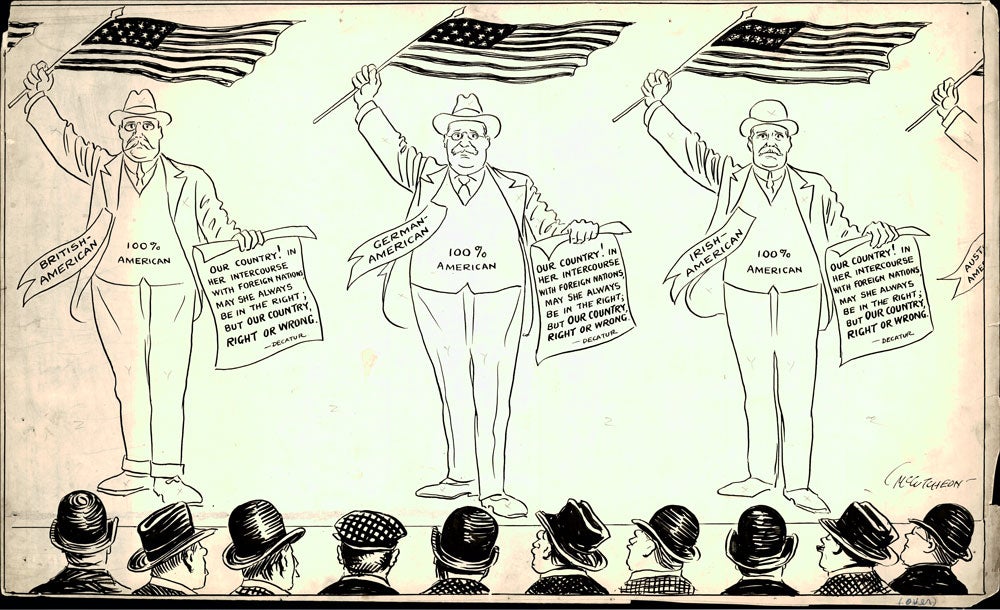
“Proper American Fashion for 1915” (February 9, 1915)
by John Tinney McCutcheon (1870-1949)
13 x 22 in., ink on drawing board
Coppola Collection
On the Purdue campus, where he was a student, McCutcheon (class of 1889) is memorialized in a coeducational dormitory, John T. McCutcheon Hall. The lobby displays an original of one of his drawings, a nearly life-size drawing of a young man.
After college, McCutcheon moved to Chicago, Illinois, where he worked at the Chicago Morning News (later: Chicago Record) and then at the Chicago Tribune from 1903 until his retirement in 1946. McCutcheon received the Pulitzer Prize for Cartoons in 1932.
Immigration to North America has always been a hot topic. The first immigrants appear to have come in about 13,000 years ago, when settlers at the land bridge from Asia could begin to move when the ice retreated after the last Ice Age. The land bridge went under water and large civilizations flourished up and down the Americas until 500 years ago, when the Europeans arrived from the other direction. Waves of explorers, conquerors, and settlers exterminated and reshaped the culture in the “New World.”
The new United States (that start-up country) was a welcome destination. A large wave of Irish and German immigrants, in the early to mid-1800s, was followed by the Italians in the later part of the century. Once you have a clear “them” and “us,” though, things change.
The Immigration Restriction League supported literacy as a prerequisite for immigration from its formation in 1894.
In 1895, Henry Cabot Lodge had introduced a bill to the United States Senate to impose a mandate for literacy for immigrants, using a test requiring them to read five lines from the Constitution. Though the bill passed, it was vetoed by President Grover Cleveland in 1897. In 1901, President Theodore Roosevelt lent support for the idea in his first address, but the resulting proposal was defeated in 1903.
A literacy test was included in a US Senate immigration bill of 1906, but the House of Representatives did not agree to this, and the test was dropped in the conference committee finalizing what became the Immigration Act of 1907. Literacy was introduced again in 1912 and though it passed, it was vetoed by President William Howard Taft. By 1915, yet another bill with a literacy requirement was passed. It was vetoed by President Wilson because he felt that literacy tests denied equal opportunity to those who had not been educated.
As World War I erupts in Europe, President Wilson formally proclaims the neutrality of the United States, a position that a vast majority of Americans favored, on August 4, 1914.
The loyalty of the Immigrant-Americans is addressed in this poignant cartoon.
We know, 36 years later, Japanese-Americans were interred after the attack on Pearl Harbor. I wonder if German-Americans and Italian-Americans would have gotten the same treatment if the Nazis had managed to attack New York City.


